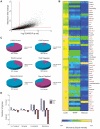A quantitative comparison of cell-type-specific microarray gene expression profiling methods in the mouse brain
- PMID: 21304595
- PMCID: PMC3029380
- DOI: 10.1371/journal.pone.0016493
A quantitative comparison of cell-type-specific microarray gene expression profiling methods in the mouse brain
Abstract
Expression profiling of restricted neural populations using microarrays can facilitate neuronal classification and provide insight into the molecular bases of cellular phenotypes. Due to the formidable heterogeneity of intermixed cell types that make up the brain, isolating cell types prior to microarray processing poses steep technical challenges that have been met in various ways. These methodological differences have the potential to distort cell-type-specific gene expression profiles insofar as they may insufficiently filter out contaminating mRNAs or induce aberrant cellular responses not normally present in vivo. Thus we have compared the repeatability, susceptibility to contamination from off-target cell-types, and evidence for stress-responsive gene expression of five different purification methods--Laser Capture Microdissection (LCM), Translating Ribosome Affinity Purification (TRAP), Immunopanning (PAN), Fluorescence Activated Cell Sorting (FACS), and manual sorting of fluorescently labeled cells (Manual). We found that all methods obtained comparably high levels of repeatability, however, data from LCM and TRAP showed significantly higher levels of contamination than the other methods. While PAN samples showed higher activation of apoptosis-related, stress-related and immediate early genes, samples from FACS and Manual studies, which also require dissociated cells, did not. Given that TRAP targets actively translated mRNAs, whereas other methods target all transcribed mRNAs, observed differences may also reflect translational regulation.
Conflict of interest statement
Figures




Similar articles
-
Molecular characterization of neuronal cell types based on patterns of projection with Retro-TRAP.Nat Protoc. 2015 Sep;10(9):1319-27. doi: 10.1038/nprot.2015.087. Epub 2015 Aug 6. Nat Protoc. 2015. PMID: 26247298
-
A versatile method for cell-specific profiling of translated mRNAs in Drosophila.PLoS One. 2012;7(7):e40276. doi: 10.1371/journal.pone.0040276. Epub 2012 Jul 6. PLoS One. 2012. PMID: 22792260 Free PMC article.
-
Gene expression analysis of neural cells and tissues using DNA microarrays.Curr Protoc Neurosci. 2008 Oct;Chapter 4:Unit 4.28. doi: 10.1002/0471142301.ns0428s45. Curr Protoc Neurosci. 2008. PMID: 18972379
-
Characterization of mRNA expression in single neurons.Methods Mol Biol. 2007;399:133-52. doi: 10.1007/978-1-59745-504-6_10. Methods Mol Biol. 2007. PMID: 18309930 Review.
-
Single cell gene expression profiling in Alzheimer's disease.NeuroRx. 2006 Jul;3(3):302-18. doi: 10.1016/j.nurx.2006.05.007. NeuroRx. 2006. PMID: 16815214 Free PMC article. Review.
Cited by
-
CellMapper: rapid and accurate inference of gene expression in difficult-to-isolate cell types.Genome Biol. 2016 Sep 29;17(1):201. doi: 10.1186/s13059-016-1062-5. Genome Biol. 2016. PMID: 27687735 Free PMC article.
-
The Future of Cross-Linking and Immunoprecipitation (CLIP).Cold Spring Harb Perspect Biol. 2018 Aug 1;10(8):a032243. doi: 10.1101/cshperspect.a032243. Cold Spring Harb Perspect Biol. 2018. PMID: 30068528 Free PMC article. Review.
-
RiboTag is a flexible tool for measuring the translational state of targeted cells in heterogeneous cell cultures.Biotechniques. 2015 Jun 1;58(6):308-17. doi: 10.2144/000114299. eCollection 2015 Jun. Biotechniques. 2015. PMID: 26054767 Free PMC article.
-
Biology and Bias in Cell Type-Specific RNAseq of Nucleus Accumbens Medium Spiny Neurons.Sci Rep. 2019 Jun 6;9(1):8350. doi: 10.1038/s41598-019-44798-9. Sci Rep. 2019. PMID: 31171808 Free PMC article.
-
Corticospinal-specific HCN expression in mouse motor cortex: I(h)-dependent synaptic integration as a candidate microcircuit mechanism involved in motor control.J Neurophysiol. 2011 Nov;106(5):2216-31. doi: 10.1152/jn.00232.2011. Epub 2011 Jul 27. J Neurophysiol. 2011. PMID: 21795621 Free PMC article.
References
-
- Arlotta P, Molyneaux BJ, Chen J, Inoue J, Kominami R, et al. Neuronal subtype-specific genes that control corticospinal motor neuron development in vivo. Neuron. 2005;45:207–221. - PubMed
Publication types
MeSH terms
Substances
LinkOut - more resources
Full Text Sources
Other Literature Sources
Miscellaneous

